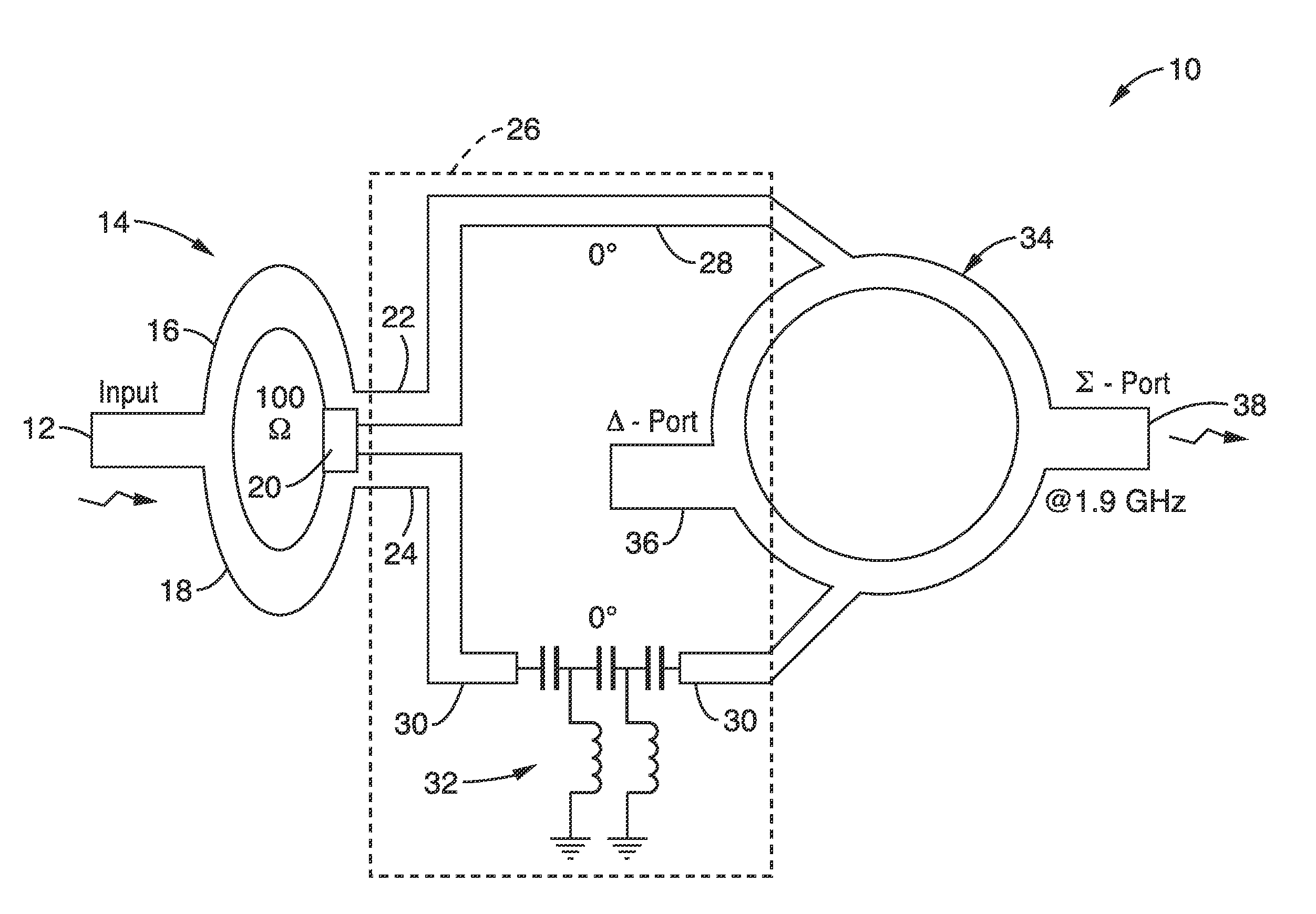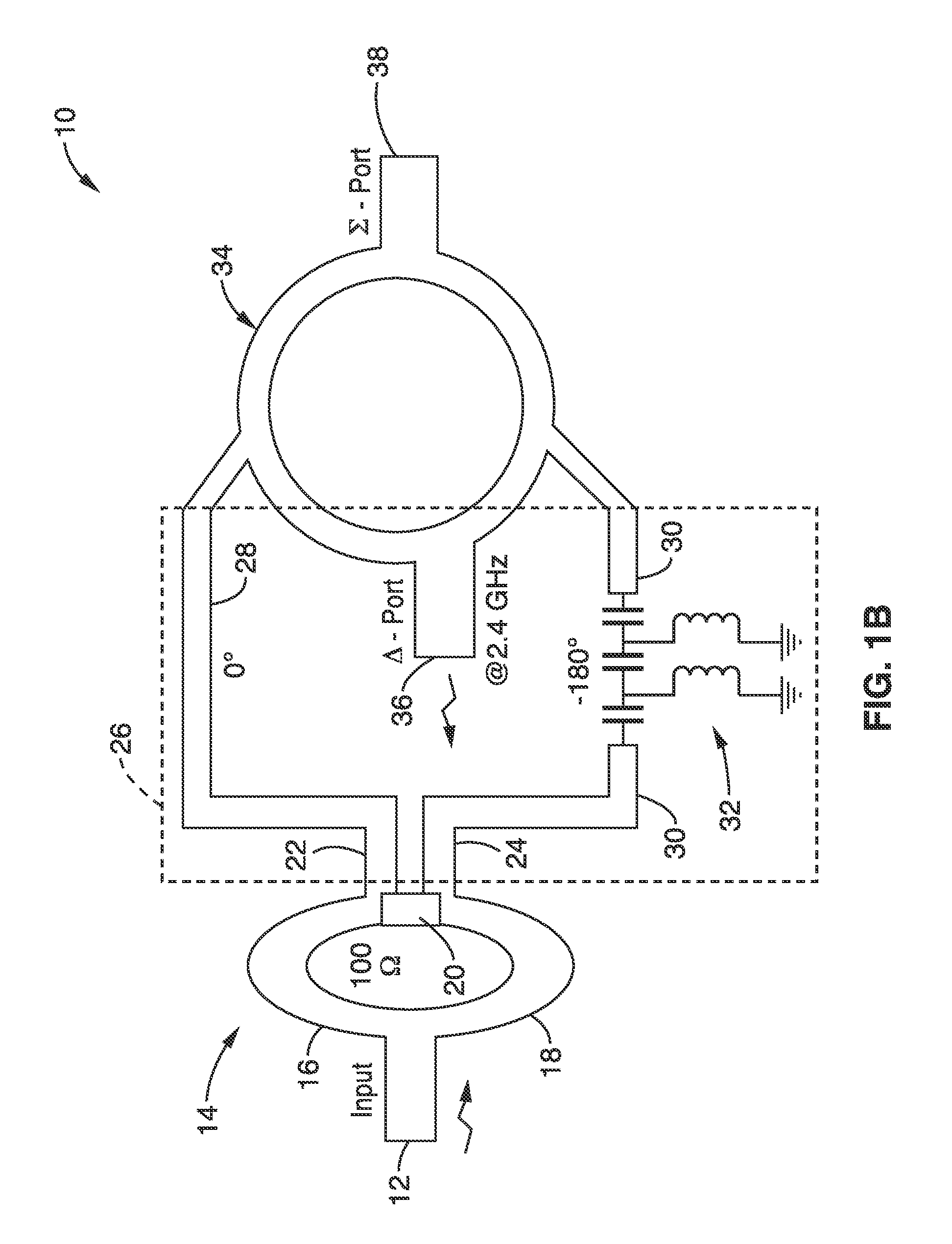Diplexer synthesis using composite right/left-handed phase-advance/delay lines
a phase-advance/delay line and composite technology, applied in the field of diplexers, can solve the problems of time-consuming process of parameter optimization of the three-port junction connecting the filter and the requisite performance tuning, and achieve the effect of high level of agreemen
- Summary
- Abstract
- Description
- Claims
- Application Information
AI Technical Summary
Benefits of technology
Problems solved by technology
Method used
Image
Examples
embodiment 10
[0056]Delay line 32 is configured with CRLH transmission structures to provide arbitrary dual-band operation, and is designed to have (0°, −180°) phase responses at a first and second operating frequency. The example implementation of embodiment 10 depicts a diplexer designed for a first frequency of 1.9 GHz and a second frequency of 2.4 GHz, and a characteristic impedance of 50 Ω.
[0057]As shown in FIG. 1A, at 1.9 GHz the phase progression along two paths of the delay line are identical, which helps signal construction at the Σ port 38. On the other hand, the anti-phase signals from the delay line cause signals at 2.4 GHz to appear at the Δ port 36 as indicated in FIG. 1B. Therefore, the frequency selective mechanism is achieved.
[0058]The phase nonlinearity and controllability of the CRLH structures allow arbitrary dual-band operation while keeping the diplexer structure compact. At least one embodiment of the invention can be implemented using a single-band 180° hybrid for diplexin...
embodiment 1
[0079]2. An apparatus , wherein said apparatus comprises a diplexer.
[0080]3. An apparatus according to embodiment 1, wherein said power divider is configured as a three-port junction outputting said first signal and said second signal which are in phase with each other with equal frequency makeup and at substantially equal power.
[0081]4. An apparatus according to embodiment 1, wherein said power divider comprises a Wilkinson power divider.
[0082]5. An apparatus according to embodiment 1, wherein said phase delay line is configured for introducing a first phase delay or advance at the first operating frequency ƒ1, and a second phase delay or advance at the second operating frequency ƒ2.
[0083]6. An apparatus according to embodiment 1, wherein said CRLH hybrid coupler comprises composite right / left-handed (CRLH) transmission line (TL) material having both right-handed (RH) and left-handed (LH) portions.
[0084]7. An apparatus according to embodiment 1, wherein said CRLH hybrid coupler co...
embodiment 16
[0094]17. An apparatus , wherein said CRLH phase delay line is configured for providing a first phase delay at the first operating frequency ƒ1, and a second phase delay at the second operating frequency ƒ2, and in which the first phase delay and the second phase delay are not equal.
[0095]18. An apparatus according to embodiment 16, wherein dual frequency characteristics of each transmission line (TL) segment of said CRLH hybrid coupler arise in response to an anti-parallel relationship between phase and group velocities below a transition frequency ω0, within left-handed (LH) material within the CRLH hybrid coupler, and a parallel relationship between phase and group velocities above transition frequency ω0 within the right-handed material (RH) within the CRLH hybrid coupler.
[0096]19. An apparatus for diplexing an input signal, comprising: a power divider configured for splitting an input signal into a first signal and a second signal which are in phase with each other having equal...
PUM
 Login to View More
Login to View More Abstract
Description
Claims
Application Information
 Login to View More
Login to View More - R&D
- Intellectual Property
- Life Sciences
- Materials
- Tech Scout
- Unparalleled Data Quality
- Higher Quality Content
- 60% Fewer Hallucinations
Browse by: Latest US Patents, China's latest patents, Technical Efficacy Thesaurus, Application Domain, Technology Topic, Popular Technical Reports.
© 2025 PatSnap. All rights reserved.Legal|Privacy policy|Modern Slavery Act Transparency Statement|Sitemap|About US| Contact US: help@patsnap.com



